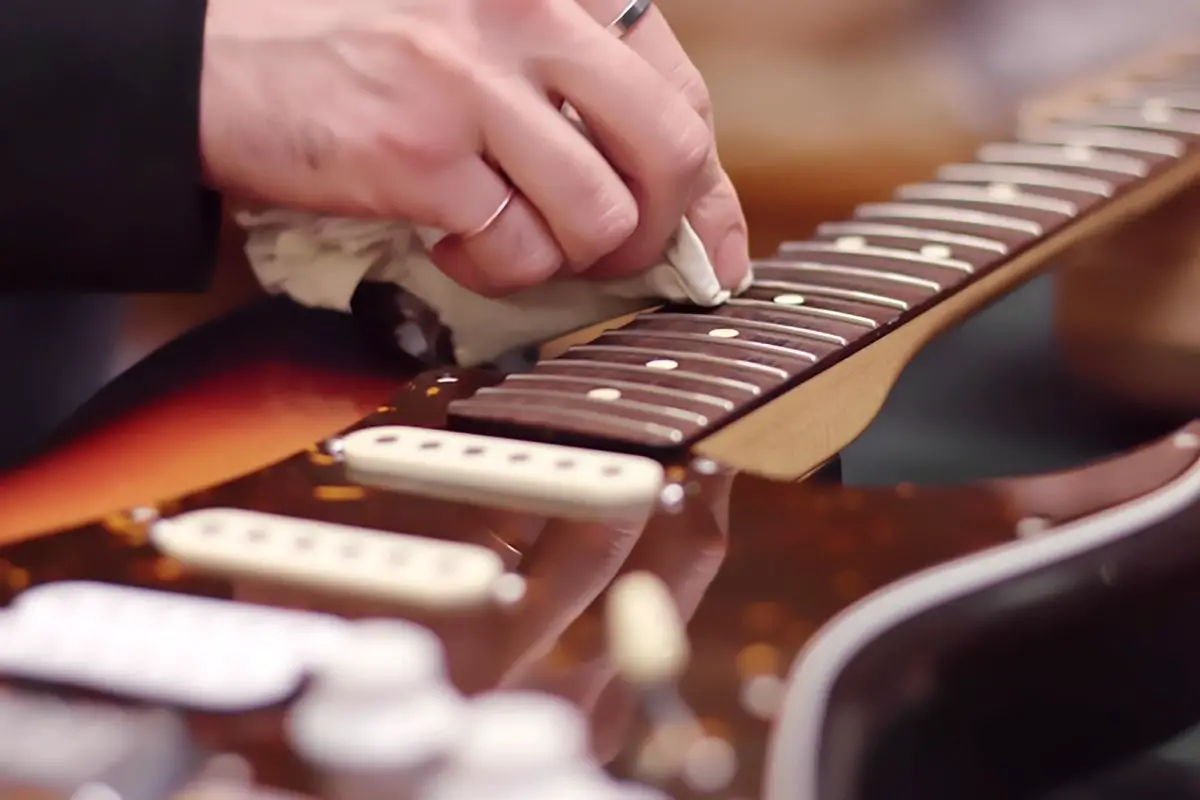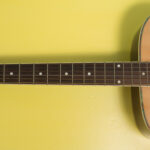As a guitarist, I’ve often wondered about the potential risks of leaving my guitar in a hot car, especially during those scorching summer days. High temperatures can have a significant impact on the overall condition and longevity of a guitar, making it crucial to understand the effects of heat and humidity on these instruments.
Guitars are crafted from delicate materials like wood and glue, which are sensitive to changes in temperature and moisture levels. When exposed to excessive heat, these materials can expand or contract, leading to warping, shrinking, and even permanent damage.
The specific effects of leaving a guitar in a hot car can vary depending on the guitar type – acoustic or electric – but in general, it’s best to avoid this practice.
Key Takeaways on Can You Leave a Guitar in a Hot Car?
- Heat can cause significant damage to guitars, including warping and shrinking
- Different guitar types, such as acoustic and electric, can be affected differently by heat exposure
- Taking preventative measures, like using a proper case, can help to minimize the risks of heat-related damage
Don’t miss out on these other top picks in this category:
- Can You Cut Guitar Strings with Scissors?
- Can I Use a Coin as a Guitar Pick?
- Can Guitar Strings Cut Your Fingers?
The Effect of Heat on Guitars
Acoustic and electric guitars both can be affected by temperature changes, especially high temperatures and extreme heat. In this section, I will discuss the consequences of leaving a guitar in a hot car and the importance of maintaining the right environment for your instrument.
When exposed to high temperatures, guitars can suffer from warping and other forms of damage. A hot car can cause the wooden bodies of both acoustic and electric guitars to expand. As a result, the bridge, neck, and fretboard can get deformed, leading to issues such as frets loosening, a change in action height, and even the separation of the guitar’s binding.
Humidity is another factor to consider when dealing with guitars and hot weather. A proper humidity level, ranging from 40% to 50%, is essential for the instrument’s well-being. In a hot car, humidity levels can fluctuate, causing the wood to swell or contract, which can exacerbate the aforementioned warping effect.
For acoustic guitars, heat exposure can be particularly damaging. High temperatures can cause the glue used to hold the bridge and neck in place to loosen, which can lead to these components falling off. In extreme cases, the entire guitar may become unplayable, and the repair process can be time-consuming and expensive.
Electric guitars are not immune to the effects of heat either. Similar to acoustic guitars, the wooden bodies of electric guitars can get damaged due to warping and expansion. In addition, the temperature changes can affect electrical connections, which can lead to issues with pickups and other electronics.
To prevent these problems, keep your guitars in a temperature-controlled environment, ideally ranging from 70-75 degrees Fahrenheit (21-24 degrees Celsius). Avoid leaving your guitar in a hot car, especially on sunny days, when the interior temperature can rise 20 to 30 degrees Fahrenheit above the outside temperature within just 20 to 30 minutes.
Specific Parts of a Guitar Susceptible to Heat Damage
The Neck and Truss Rod
Guitar neck, particularly the truss rod inside is one of the most vulnerable parts when exposed to high temperatures. Heat can cause the neck to bow or warp, throwing off the guitar’s action entirely. This can be a real problem, especially for a solid wood guitar, as humidity decreases in high temperatures and the wood dries out and cracks.
The Fretboard and Frets
Another part that suffers from high temperatures is the fretboard. In extreme cases, the fretboard may shrink or expand due to heat exposure. This change results in fret sprout, where the frets extend beyond the edge of the fretboard, leading to sharp and uncomfortable edges.
The Bridge and Nut
The bridge and nut are also susceptible to the heat. Being glued to the body, they may become unstuck or misaligned. Particularly in acoustic guitars, the heat may cause the bridge to pull away from the body. Since the nut is closer to the head and neck of the guitar, it can also experience warping, leading to issues with string spacing and intonation.
The Body and Glue Joints
Lastly, guitar body, along with glue joints, are prone to heat damage. For hollow body guitars, this could result in cracks and distortion of the sound. The glue holding various parts of the guitar together may also weaken and joints can start coming apart. Solid wood guitars often suffer more from the heat than those made of laminated wood or composite materials.
Impact of Humidity on Guitars
Humidity plays a significant role in the well-being of both acoustic and electric guitars. It is essential to maintain the appropriate humidity levels in the environment where you store or play your instrument. High or low humidity levels can lead to various issues that may compromise the integrity and sound of your guitar.
When there is a lot of humidity in a hot car, it can harm the guitar because the wood will absorb moisture from the air. This excessive moisture can make the wood swell, ruining the guitar’s shape.
On the other hand, if humidity levels are too low, the fretboard could shrink, which may cause the frets to become loose. Additionally, condensation can form inside the car, leading the wood to absorb moisture and potentially causing the guitar to warp or split.
Solid wood guitars, such as many acoustic guitars, are more sensitive to changes in temperature and humidity, making them more prone to damage in hot environments. Laminate guitars, often found in electric guitars, are made from multiple layers of wood pressed together with glue, making them more resistant to warping and cracking.
It is worth mentioning that rapid changes in humidity can be destructive too. Such changes can happen when moving a guitar from a cold car to a warm environment or vice versa. These sudden shifts can cause the wood to expand or contract, leading to structural issues.
The Effect of Leaving a Guitar in a Car
As a guitarist, you have to be mindful of the risks associated with storing a guitar in both hot and cold car environments.
When left in a hot car, three main problems can arise:
- Fret loosening: The wooden fretboard and the metal frets expand at different rates, causing them to loosen.
- Out-of-tune strings: The heat causes the strings to expand, leading to an out-of-tune guitar.
- Sunlight damage: Direct sunlight can cause damage to the body of the guitar, particularly in the case of acoustic guitars.
In a cold car, humidity is a major concern. When you expose your instrument to changing humidity levels, especially rapid changes, it can be damaging. High humidity can cause swelling in the guitar’s wooden components, while low humidity can cause cracking or warping.
To minimize these risks, consider these precautions:
- Park in the shade: Find a shaded spot to park, reducing the temperature inside the car.
- Crack the windows: Open the windows slightly to allow air circulation, preventing the buildup of heat and humidity.
- Avoid the trunk: As trunks can get hotter and colder than the rest of the car, avoid leaving your guitar there.
The Importance of Guitar Case When Traveling

When travelling with your instrument, it’s essential to use a guitar case, specifically a hard-shell case, to ensure maximum protection. There are multiple reasons why a hard case or hardshell case is a great investment for keeping a guitar safe during travel.
Firstly, a hard case offers better protection against physical damage. While on the road, a guitar can easily be bumped or accidentally dropped, which could lead to scratches, dents, or even structural damage to the body or neck. A hardshell case provides a tough outer layer that can absorb and distribute the impact, helping to reduce potential damage.
Additionally, using a hard case can help protect your guitar from temperature changes. Although you should make efforts to avoid prolonged exposure to high temperatures, a hardshell case can provide an extra layer of insulation.
Temperatures inside a car can rise up to 20-30 degrees Fahrenheit above the outside temperature in just 20-30 minutes. A hard case can help protect the guitar from such extreme heat and its damaging effects, such as softening the wood glues and potentially causing the bridge to loosen.
Moreover, a hard case also helps protect your guitar from humidity fluctuations. Humidity can have detrimental effects on the wood, glue, and overall structural integrity of a guitar. Using a hard case can help reduce exposure to sudden changes in humidity that could lead to warping, cracking, or other damage.
Finally, a hard-shell case also offers the convenience of storage space for guitar accessories. Storage pockets for small items like picks, capos, and tuners, keeps everything you need in one place, making life a little easier when travelling with your guitar
Investing in a hard case or hard-shell case is a crucial step for any guitarist who wants to ensure the safety and longevity of their instrument while traveling. It offers protection against physical damage, temperature changes, and humidity fluctuations while providing convenient storage for accessories. So the next time you hit the road with your guitar, make sure you have a solid, protective case to rely on.
Special Considerations for Acoustic and Electric Guitars
When it comes to leaving guitars in a hot car, there are some differences between acoustic and electric guitars that I’d like to address. Let me begin with acoustic guitars, which tend to be more sensitive to temperature changes due to their construction.
Acoustic guitars are primarily made of wood, which can expand and contract when exposed to extreme heat. This can lead to minor cracks in the wood and where the wood joins together, affecting the resonance of the guitar.
Also, temperatures above 90°F (32°C) can damage the glue that holds the guitar’s joints together, reducing its overall stability and potentially destroying it. Moreover, the frets could loosen as the wooden fretboard and metal frets expand at different rates, making the guitar go out of tune.
On the other hand, electric guitars are somewhat less susceptible to temperature changes due to their solid body construction. However, they are still not immune to the effects of heat. Prolonged exposure to high temperatures can have an impact on the metal parts and electronics within electric guitars.
The strings could expand, causing the guitar to go out of tune. Additionally, high heat can affect the performance of the pickups, which are an essential component of electric guitars. The heat can cause the magnets inside the pickups to lose some of their magnetic strength, resulting in a weaker signal and affecting the tone of the guitar.
Also note that in both acoustic and electric guitars, rapid temperature changes, like moving from an air-conditioned space to a hot car, can cause the wood to warp. The constant shrinking and expansion of the wood put pressure on the glue and joints, increasing the chances of damage to the guitar.
Mitigating the Risks: Tips and Maintenance
Now that I’ve explored the potential risks of leaving a guitar in a hot car, it’s important to address ways to mitigate those risks and maintain the instrument’s quality. To begin, make sure to park the car in a shaded area to reduce the temperature within the vehicle. When it’s not possible to find shade, use a sunshade or cover for the windows to limit direct sunlight and heat buildup.
As the humidity levels inside the car can change drastically due to temperature fluctuations, it is essential to monitor these changes. Guitars are sensitive to humidity, which can cause issues such as warping or damage to the wood.
Maintain a balanced humidifier in the guitar case to keep the instrument in optimum condition. Additionally, consider storing a separate humidity monitoring device in the guitar case to ensure appropriate moisture levels are maintained.
Regardless of temperature and humidity, routine maintenance is crucial to the guitar’s longevity and performance. When leaving a guitar in a hot car, be sure to check its quality upon retrieval. Perform a visual inspection to ensure there is no visible damage, such as cracked paint or warped wood, examining the neck to ensure it remains straight and comfortable to play.
For added protection, wrap the instrument in a blanket or other insulating material to provide a barrier against potential temperature fluctuations. However, do not use a material that retains moisture or dampness, as this could exacerbate humidity issues.
Lastly, invest in a high-quality hard-shell case designed to protect the guitar from temperature changes and damage. This type of case not only provides better insulation against heat but also helps shield the instrument from humidity variations.
Conclusion
I want to emphasize how crucial it is to avoid leaving your guitar in a hot car, as it can lead to several damages and issues. Within just a few hours, the rapid increase in temperature inside a closed vehicle can cause harm to your instrument.
In a hot environment, components of a guitar such as the strings, bridge, and neck, may expand and contract at different rates. These changes cause tension in the instrument, eventually leading to cracks and even total detachment of parts. As a guitarist, I would not want to see my instrument’s headstock or any other part get damaged due to heat exposure.
Furthermore, one common issue with many stringed instruments is the loosening of frets. This happens when the metal frets and wooden fretboard expand at different rates, forcing the metal frets out of their slots. Not only will this impediment require the intervention of skilled luthiers, but the process can be quite costly as well.
Lastly, heat can also affect the glue that binds parts of a guitar together. Hide glue, commonly used in guitar construction, is susceptible to high temperatures and may fail in hot conditions. This weakening will cause the guitar’s structure to loosen or even fall apart.
To safeguard your guitar from any of these adverse effects, it’s essential to store it in a stable environment with optimal temperature and humidity levels. If you ever find yourself in a situation where you have to leave your guitar in a car temporarily, try to park in a shaded area and crack the windows. However, avoiding hot cars entirely serves as the best course of action in the long run.
Frequently Asked Questions
Does a guitar case offer heat protection?
A guitar case, especially a hardshell case, offers some protection against heat; however, it cannot completely shield your instrument from extreme temperatures.
A hardshell case can help slow down the process of heating, but it’s not a foolproof solution. It’s still best to avoid leaving your guitar in a hot car for extended periods.
At what temperature can a guitar be damaged?
Guitar damage can occur when temperatures inside a car exceed 120 degrees Fahrenheit (48 degrees Celsius). High temperatures can cause the wood to warp, glues to loosen, and finishes to crack. To minimize the risk, try to keep your guitar in a more controlled environment where temperatures won’t rise to such extremes.
How long is it safe to leave a guitar in a hot car?
You should avoid leaving your guitar in a hot car any longer than absolutely necessary. In as little as 20 to 30 minutes, temperatures inside a closed car can rise 20 to 30 degrees Fahrenheit above the outside temperature, quickly reaching potentially harmful levels.
If you must leave your guitar in a car, consider parking in a shaded area or utilize other methods to keep the car cooler.
What are the effects of heat on a guitar?
Heat can cause a number of issues for guitars. The wood may warp or split due to changes in humidity inside the hot car. The fretboard can shrink, leading to loose frets.
In addition, the glue holding various parts of the guitar together may weaken, and the instrument’s finish could crack. All of these issues may impact the playability and overall life of your guitar.
How to prevent heat damage to a guitar?
To prevent heat damage, avoid leaving your guitar in a hot car or other areas with extreme temperatures. If you must leave the guitar in a car, park in a shaded area or use sunshades to reduce the temperature inside the vehicle.
Invest in a hardshell case for added protection, and consider using a humidity control device inside the case to help maintain proper humidity levels.
Can heat cause tuning issues for guitars?
Yes, heat can cause tuning issues for guitars. As the wood and other materials in a guitar expand and contract due to temperature changes, the tension of the strings can be affected, causing them to go out of tune.
Additionally, the wood’s physical changes could impact the overall playability and intonation of the instrument. It’s crucial to check the tuning and make any necessary adjustments after exposing your guitar to significant temperature fluctuations.

My name is Howard Matthews and I have been playing the guitar since I was knee-high. My parents like to joke that I was pulling the strings even before I was born. In fact, one of my earliest memories is sitting on the couch with my dad’s guitar, wreaking havoc on the chords.
Now, 40 years later, I can attest that I play them much better than I did back then. I have followed in the footsteps of both my parents – much to their delight – and have been the main guitarist in my band for the best part of three decades.
Music has always been my passion, and until recently my life has been so consumed with it that I haven’t had a moment to have a breath (and I wouldn’t have it any other way)!








